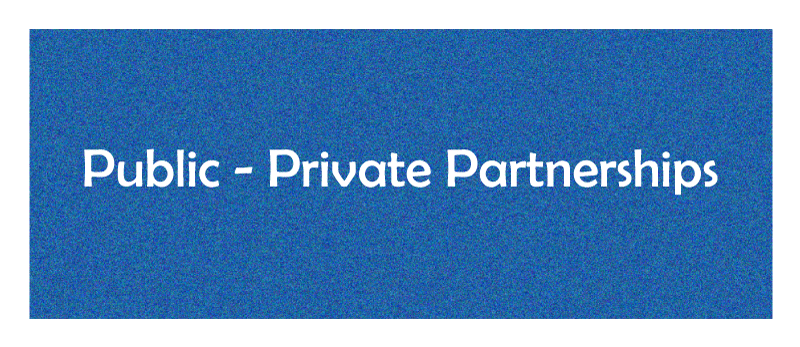Public-Private Partnerships (PPPs): Definition, How They Work, and Examples"Public-private Partnerships" are typical collaborations between a government organization and a business from the private sector that can be used to fund, create, and operate projects like parks, convention centres, and public transit systems. A project's funding via a "public-private partnership" may enable a project to complete earlier or make it possible in the first place. 
Public-private partnerships may give private, for-profit firms partial ownership rights over property and services that are ostensibly public, liability protection, or benefits of tax or other operational revenue. How do Public-Private Partnerships work?A private company might be eager to fund the development of a capital-intensive building project in exchange for obtaining the operational profits after it is finished. In contrast, a city government may be highly indebted and unable to do so. In such a case, a public-private partnership may be established. Contract terms for public-private collaborations are often 20 to 30 years or more. Although some of the funding is provided by the private sector, during the course of the project, users or the public sector must make payments. While the "Public" partner concentrates on establishing and ensuring conformity with the objectives, the "Private" partner works on the project's design, completion, execution, and funding. Through a negotiation process, risks are ideally divided between the private and public parties; it is not usually done in accordance with each party's capacity to evaluate, manage, and deal with them. Even though public works and services may be funded by a fee from the public authority's revenue budget, as in the case of hospital projects, concessions may entail the ability to direct users' payments, as in the case of toll highways. Payments are made according to how much of a service is used in situations like highway shadow tolls. Payment for wastewater treatment is made by user fees that are collected by the respective organizations. Advantages and Disadvantages of PPPAdvantagesGovernments and private firms benefit from such partnerships in the same way. For instance, technology and innovation from the private sector can aid in increasing the operational effectiveness of delivering public services. On the other hand, the public sector offers incentives to the private sector so that it can complete projects on schedule and within budget. Additionally, fostering economic diversity increases a nation's ability to compete by supporting its infrastructural foundation and fostering related industries, including construction, equipment, support services, and other enterprises. DisadvantagesThere are drawbacks as well. A public-private partnership may come with unique risks for the private partner. Construction risks exist when building physical infrastructures, like roads or railroads. Usually, the private partner is responsible if the product is late, costs more than expected, or has technical flaws. Furthermore, the private partner confronts availability risk if it is unable to deliver the promised service. For instance, a firm might not adhere to safety or other pertinent quality requirements when managing a prison, hospital, or school. Demand risk arises when fewer people than anticipated use a service or infrastructure, like toll highways, bridges, or tunnels. However, if the public partner accepted to pay a minimum fee regardless of the demand, this risk may be moved to the public partner. From the viewpoint of the general public and taxpayers, public-private partnerships can pose hazards. Partnerships between private operators and the government may protect them from accountability to public service customers for taking excessive shortcuts, offering subpar service, or violating people's civil or constitutional rights. In addition, the private partner may be in a position to increase tolls, tariffs, and taxes for captive customers who may be required to pay for their services by the law or a regional natural monopoly. Public-private partnerships can also lead to challenging principal-agent issues, like any arrangement where ownership and decision powers are divided. Public-Private Partnership ExamplesInfrastructure for transportation, including highways, airports, trains, bridges, and tunnels, frequently uses public-private partnerships. Infrastructure for municipalities and the environment's water or wastewater systems are also public-private partnership constructions. Other instances may include public service accommodations like jails, student housing, amusement parks, and school buildings.
Next TopicQQQQ
|
 For Videos Join Our Youtube Channel: Join Now
For Videos Join Our Youtube Channel: Join Now
Feedback
- Send your Feedback to [email protected]
Help Others, Please Share










